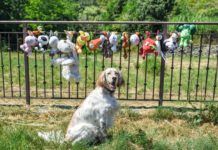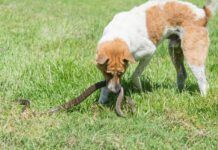by Pat Miller
First, there was Kong. Originally designed as a fetch item, the hard rubber toy bounced into the lead as a training tool when some enterprising dog person realized you could pack it full of yummy stuff as a doggie distractor. A food-filled Kong can be used to keep a dog occupied while you complete other tasks, or help him stay busy and content after you leave for work. Unstuffing the food is also a self-reinforcing activity, rewarding the dog for persisting in his efforts to chew, lick, and thump the treats free.
The past two decades have seen positive training methods rise to prominence, as well as an increase in number of dogs who spend their weekdays home alone. Not surprisingly, there has been a concomitant increase in the dog training industry’s interest in Kong and other interactive toys as tools to distract and occupy dogs – and to delight dog owners. In the past three or so years alone, there have been a dozen or more of these toys introduced to the market.
We collected as many of these toys as we could for testing and review. The Miller dog pack was very pleased and excited to be called upon to examine them.
The products we found fell into two groups: toys that, as with the Kong, you give to your dog, walk away, and let him lick and gnaw to his heart’s content (we’ll call them “leave ’em alone” toys); and “instructional learning” products, where the dog learns to perform a task, but needs you there to reset the puzzle so he can perform the task again.
Leave ’em alone toys
The Kong has long been king in this category (see “King Kongs,” WDJ October 2000). However, a new line of products from Premier (the “Busy Buddy Treat-Holding Rubber Chew Toys”) may be about to present a serious challenge to Kong. Premier has combined features from several popular dog toys into the five solid rubber products in this line. While not marketed as “indestructible,” the Busy Buddys are made of a tough yet forgiving rubber that will stand up to hours of abuse by most chewers. All are dishwasher safe. We like them a lot.
In our opinion, the best of the bunch is the purple Twist ’n Treat. The inviting rubber material and its innovative saucer shape make it a highly successful treat-dispensing toy. It’s a snap to load with its two-piece, twist-together design, and just as easy to clean. It can be twisted more tightly closed to slow the treat payout rate, or more open to pay out more generously. Blessedly, it lacks the irritating noisemaking capability of the hard plastic Buster Cube and Roll-A-Treat Ball (reviewed in “Treat-Dispensing Toys,” April 2002).
Tucker, our Cattle Dog-mix, was never assertive enough to make the Buster Cube work, but had this toy dispensing treats in mere seconds. With his gentle approach, a full load of treats lasted half an hour. Our more assertive Kelpie emptied the treats in five minutes (I should have screwed it tighter for her!) and then spent the next half-hour pushing it around, convinced there had to be more treats forthcoming.
The grooves in the surface of The Groove Thing, a marrow bone-shaped toy, are perfect for filling with soft cheese or peanut butter. The soft rubber is bonded to a tough, hollow, hard plastic core; this is intended to simulate chewy meat on a bone. The Groove Thing is messy when the grooves are filled with treat goo, so it’s best given to your dog when he’s in a crate, on a dog bed, or outside. All four of our test dogs gave this one an enthusiastic reception. It kept our Scottie busy for 45 minutes with no visible tooth marks on the surface.
The label warns that the ridges and grooves of the product can be chewed off in small pieces. If your dog is an aggressive chewer, we’d suggest choosing one of the sturdier products.
Our dogs immediately appreciated the cheese-fillable grooves on the ball-shaped ends of The Waggle, a dumbbell-shaped toy, but none of them were able to extract treats out of the ends; I could barely get them out when I went to clean it. This isn’t bad news, however, since they spent a good 30 minutes each licking out the cheese, and chewing the ends in pursuit of the treats inside. Big dogs may have more success with chewing on the ends, which have a nice give to them, thanks to the grooves.
The center bar of The Chuckle, a heavy dumbbell-shaped toy, contains a noisemaker; Premier assures us that it’s made of dog-safe components, in the unlikely event that the toy gets chewed open. The ball-shaped ends are hollow, and the holes at the ends have soft, inner-facing rubber prongs designed to randomly dispense treats. None of our dogs played with the toy violently enough to either make it “chuckle,” or to expel treats from the ends, not even Tucker, who likes to shake his pretend prey objects. He was happy to fetch the toy endlessly, however. It’s not interactive for all dogs, but a good choice for dogs who play very vigorously, with lots of shaking and chewing.
The Biscuit Bouncer is a football-shaped toy that, like Kong toys, bounces unpredictably. It’s a durable fetch toy, especially for dogs who are intrigued or aroused by random prey-like movement. Its treat-holding capacity is a little feeble to qualify it as an interactive toy, though, hence the two-paws rating. As a fetch toy we’d give it four paws.
All five of the Premier products can be found in local pet supply stores. Contact Premier to find a retailer near you.
Instructional learning toys
These are soft toys that require the dog to figure out how to operate puzzles, in reverse order from the way people work them; we put them together, dogs take them apart! You generally need to show, teach, or otherwise assist your dog in understanding the problem so he can solve it.
I was initially skeptical of the value of these toys, but I was pleasantly surprised with my dogs’ reaction to them. They are adorable, and offer a great gift-giving value. But more important, they are fun! I found myself having a great time as my dogs and I played with these products.
One caveat: Not all of the toys on the market that are described as “interactive” can meet that description. In our opinion, a toy that the dog simply pulls apart (such as a stuffed toy hamburger with sections that are Velcroed together) does not meet this definition. In our book, truly interactive toys require (and inspire!) the dog to think.
Hide & Seek, a whimsical stuffed cat, was our favorite of the instructional toys we tested. It’s actually a child’s toy – not made to resist chewing by a dog – so definitely not a candidate for unsupervised play.
As the name suggests, the toy is intended to be hidden. Before you hide it, squeeze the cat’s left paw to trigger a recorded voice that says, “I’m over here!” every 30 seconds for the next 15 minutes. A motion-detecting chip inside the toy triggers a new message (“You found me! You found me! Give me a big hug! Let’s play hide and seek again!”) when the toy is found and picked up.
You can teach your dog to find the toy by having him follow the voice to increasingly challenging hiding places. The unique concept is a great training aide to teach “Find it” behavior. It only took a couple of repetitions for our Scottie to understand the meaning of the “I’m over here!” cue (Find it = treat!), and in just minutes he was finding the cat in easy hides across the room.
The Plush Ring Puzzle Toy Frog, a little stuffed frog with three rings around his waist, is a great starter instructional toy. Hold the frog and encourage your dog to pull off a ring. Say “Yes!” and give him a treat when he does. When he drops the ring to eat the treat, pick it up and invite him to remove the next ring. When he gets the concept, give him the toy and see if he can remove the rings by himself.
By far the winner of the “cute” prize in our interactive toy category, the Hide A Squirrel stuffed hollow tree holds three little squirrels with squeakers. Let your dog play with the squeaky squirrels, then hide them in the tree and encourage him to pull them out. It’s more challenging than the frog above, but easily grasped by dogs who have learned to remove the frog rings.
Similar to the frog toy but more challenging, the long blue Intellibone has five rings that fit more snugly than the frog’s. Dogs have to work harder to pull these off.
The IQube is designed with the same concept as the squirrel toy; a dog has to burrow his nose into the soft cube to retrieve four plush, squeaky balls. It’s slightly more difficult to retrieve the balls than the squirrels, but not too hard.
The Egg Baby Turtle is very difficult to operate. Our Scottie, who mastered all the others in short order, hasn’t yet managed to retrieve the green plush eggs that fit very snugly into the turtle’s tummy. This toy might delight a more determined dog, or one who loves to pull the “guts” out of other toys. Also available in Dino, Duck, and Fish guises.




